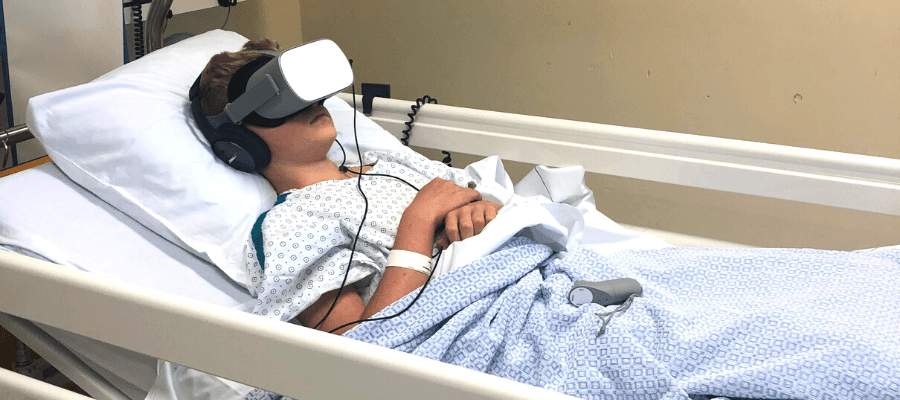The emergence of Augmented Reality (AR) and Virtual Reality (VR) solutions in healthcare marks a significant turning point in the way medical training and care are delivered and monitored. By combining advanced technologies with clinical requirements, these tools provide unparalleled visual immersion, enhancing interactivity in learning and precision in clinical practice.
Doctors, students, and patients can now benefit from innovative approaches that redefine the boundaries of what's possible in medicine.

Augmented Reality (AR) is leading the technological transformation in the medical field, merging the digital world with reality to provide healthcare professionals with unique tools to enhance patient care. AR is reshaping the landscape of modern medicine, with applications in operating rooms, hospital corridors, training, and research. This is an overview of its groundbreaking applications in healthcare :
Augmented Surgeries:
-Powerful tools for surgeons: Hands-free access to multiple informations during surgeries.
-Real-time displays: Displaying the patient's vital signs and anatomical information.
-Data overlay: Applying MRI or CT data directly onto the patient.
-Physician communication: Identify anomalies and obtain remote consultations.

Facilitating Symptom Communication and Diagnosis:
-Better communication: AR technology facilitates communication between patients and doctors by eliminating the need for complex medical terminology.
-Visualizing medical issues: Visually demonstrating the impact of issues such as cataracts.
Medical Training:
-AR in education: Teaching students and updating doctors on new procedures.
-Remote collaboration: Experts can provide remote second opinions and additional training.

Rehabilitation:
-Safe environments: Patients can train themselves in virtual scenarios.
-Cost reduction: Increase home care access and physiotherapy with AR.
Real-time Augmented Patient Records:
-Fast access: Medical records are easily accessible via AR.
-Data security: Cloud-based storage and visualization on Smart Healthcare Medical Bracelet.
Hospital Navigation:
-Navigation assistance: AR helps navigate into complex hospital buildings.

Communications & Marketing:
-Improved communication: Complicated informations share through AR for marketing purposes.
-Detailed visualizations: Showing new products descriptions and packaging.
Research & Development:
-Enhanced collaboration: AR facilitates exchanges among researchers.
-Research innovation: Insight into 3D models and real-time experiment tracking.
By offering immersive and interactive experiences, virtual reality (VR), on the other hand, paves the way for new methods of treatment, training, and research in medicine.
Virtual Reality Therapies:
-Innovative therapeutic tools: VR provides safe environments to treat disorders like phobias and PTSD (post-traumatic stress disorder).
-Realistic simulations: Allows patients to confront their fears in a realistic environment.
-Adaptability: Therapies can be customized to the patient's needs.

Rehabilitation:
-Tailored exercises: Patients can follow personalized rehabilitation programs in a virtual environment.
-Real-time monitoring: Therapists can monitor patients' progress remotely.
Pain Management:
-Immersive distraction: VR can help reduce the perception of pain by distracting the patient.
-Alternative therapies: Using VR for non-pharmacological therapies.

Medical Education:
-Immersive training: Medical students can practice surgeries and procedures in a virtual environment.
-Remote collaboration: Experts can offer real-time training and demonstrations worldwide.
-Regular updates: Simulations can be updated with the latest techniques and advances in medicine.
-Operation preparation: Healthcare professionals can practice complex surgeries before performing them.
Communication & Marketing:
-Immersive presentations: Companies can present their new medical products or machines in an innovative way.
-Patient education: Using VR to explain complex procedures and treatments to patients.
Research & Development:
-3D modeling: Researchers can visualize complex structures in three dimensions.
-Interdisciplinary collaboration: Facilitating exchanges among researchers from different fields through VR.
Innovation in healthcare is constantly evolving. These tools have moved beyond entertainment and are now essential in medicine. They offer innovative solutions for training, diagnosis, treatment, and rehabilitation.
VR and AR enable unprecedented immersion and interaction, opening the door to personalized therapeutic approaches and more effective teaching methods.
The team at Da Viking Code can assist you in all your VR and AR projects. Contact us to discuss them further.